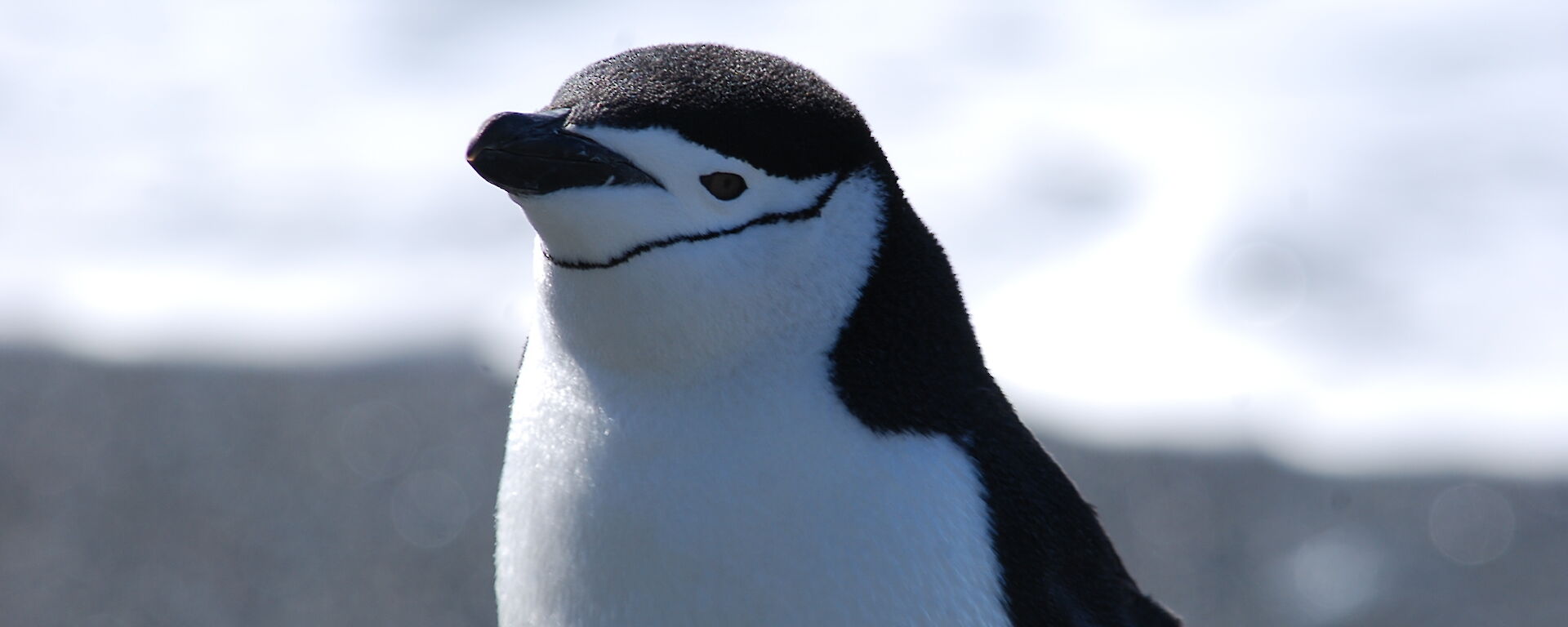Physical description and related species
Scientific name: Pygoscelis antarctica
Chinstrap penguins are distinguished by, and named for, the narrow band of black feathers, which extends from ear to ear, just below the chin and the cheeks.
Adult chinstraps weigh 3.5 to 5.5 kg. Males and females look similar, but males are larger and heavier than females.
Chinstraps have a long, black tail. Their flippers are black above and white below. Their feet range in colour from pinkish to orange, with black soles. The irises of their eyes are reddish-brown in colour.
The chinstrap penguin is closely related to two other penguins, the gentoo (Pygoscelis papua) and the Adélie (Pygoscelis adeliae). Chinstraps are a similar size to Adélies.

Distribution and abundance
Chinstrap penguins breed mainly on the Antarctic Peninsula and on islands in the South Atlantic Ocean. There is a small breeding population on the Balleny Islands, south of New Zealand, as well as South Georgia, Bouvet, and Heard Island.
Chinstrap penguins are an abundant penguin species in the Antarctic and sub-Antarctic regions. Almost all chinstrap breeding populations are found south of 60° South and are protected under the Antarctic Treaty System. However, recent evidence suggests that the number of chinstraps is declining significantly due to reductions in krill, their main food.
Conservation status: least concern.

Breeding
Chinstraps spend the winter north of the pack-ice zone and return to their colonies between October and November. Chinstraps first breed at three years of age, laying two eggs in late November. Eggs weigh between 94 to 122 grams.
Both males and females take part in the 33 to 36 day incubation period. Initially shifts last five to 10 days, but as the hatching date comes closer the shifts get shorter. They generally nurture two chicks each summer. This is unlike other penguin species where the stronger chick is fed preferentially. The chicks fledge at about seven to eight weeks.
Breeding success is lower in years when extensive sea ice persists close to colonies, as this restricts access to the sea for foraging adults.
Chicks are covered in a silver to light grey down at birth. A second, darker grey down appears at two to three weeks of age.
Chinstrap penguins can live to be 16 to 20 years old.

Diet and feeding
Although chinstrap penguins forage at sea throughout the day and night, diving effort is concentrated near midnight and noon. They generally feed in the ocean at depths of less than 40 metres, diving deeper in the daytime than at night.
Chinstrap penguins feed mainly on krill and fish. They are considered near-shore feeders, feeding close to their breeding colonies. They catch prey by pursuit-diving, using their flippers to ‘fly’ through the water.
Chinstrap penguins often toboggan on land – lying on their stomachs, propelling themselves by their feet, and using their flippers. They climb using all four limbs and are able to jump large distances to reach footholds.
In March through to early May, these penguins leave their colonies and move north of the pack ice for the winter.
Leopard seals are the chinstrap’s main predator at sea. On land, sheathbills, skuas and southern giant petrels take chicks and eggs.



